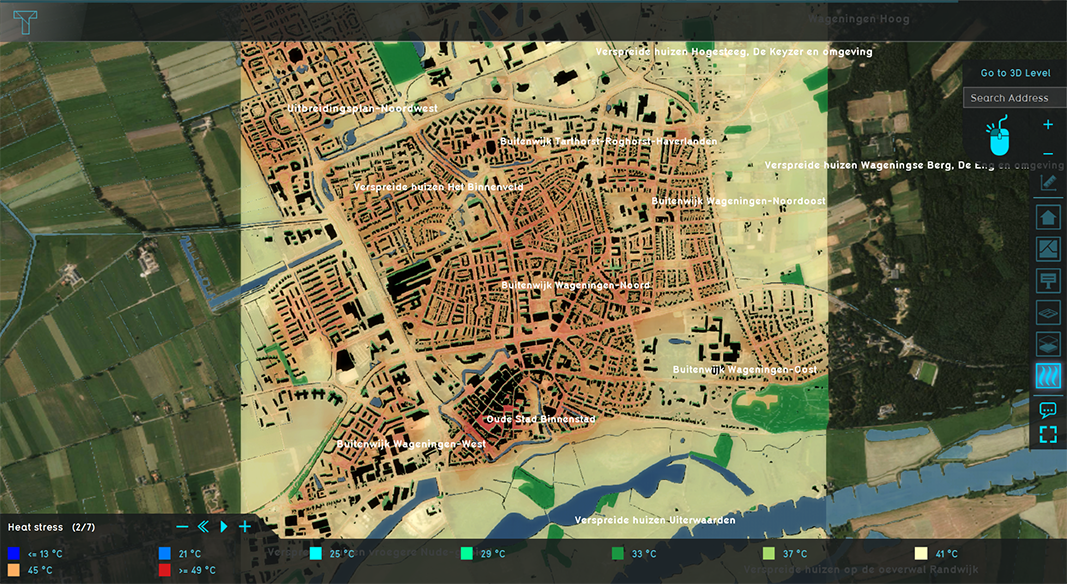DPRA Heat Module: Difference between revisions
No edit summary |
No edit summary |
||
| Line 1: | Line 1: | ||
[[File:DPRA_Heatstress_overlay.PNG|thumb|420px|right|Example of the DPRA Heat Stress overlay showing the [[Pet result type (Heat Overlay)|Physiological Equivalent Temperature result type]].]]__NOTOC__ | [[File:DPRA_Heatstress_overlay.PNG|thumb|420px|right|Example of the DPRA Heat Stress overlay showing the [[Pet result type (Heat Overlay)|Physiological Equivalent Temperature result type]].]]__NOTOC__ | ||
The Heat DPRA module is a new (as of 2019) Heat Stress Module, developed to be in accordance with the 2019 {{Template:Heat DPRA Report}}. With this module, stress tests can be performed according to the Dutch [https://www.deltaprogramma.nl] guidelines. | The Heat DPRA module is a new (as of 2019) Heat Stress Module, developed to be in accordance with the 2019 {{Template:Heat DPRA Report}}. With this module, stress tests can be performed according to the Dutch [https://www.deltaprogramma.nl | Deltaprogramma] guidelines. | ||
The Heat DPRA Module gives insight in the physiological equivalent temperature (PET), which is a form of perceived temperature, and in how it can be influenced. The PET is determined using different elements, which can be analyzed individually. As a result, the Heat DPRA Module also offers tools for shade and sun angle analyses. | The Heat DPRA Module gives insight in the physiological equivalent temperature (PET), which is a form of perceived temperature, and in how it can be influenced. The PET is determined using different elements, which can be analyzed individually. As a result, the Heat DPRA Module also offers tools for shade and sun angle analyses. | ||
Revision as of 15:02, 30 June 2023

The Heat DPRA module is a new (as of 2019) Heat Stress Module, developed to be in accordance with the 2019 DPRA Heat stress report. With this module, stress tests can be performed according to the Dutch | Deltaprogramma guidelines.
The Heat DPRA Module gives insight in the physiological equivalent temperature (PET), which is a form of perceived temperature, and in how it can be influenced. The PET is determined using different elements, which can be analyzed individually. As a result, the Heat DPRA Module also offers tools for shade and sun angle analyses.
A clip showcasing an overview of the module's functionalities can be found here.
Configuration
The DPRA Heat module is the default module for the Heat stress Overlay. When a Heat stress Overlay is added, it can immediately be configured using the Heat Overlay configuration wizard.
For more information on the configurable model attributes, see Heat Overlay model attributes and Heat Overlay feature attributes.
Available Result Types
The Heat Overlay allows user to visualize a generated Physiological Equivalent Temperature (PET) overlay, along with other intermediate overlay results. The Heat Overlay wizard allows users to select which results should be generated. For further information on the available results, see Heat Overlay result types.
Theory
The calculation models and formulas are documented. The DPRA Heat Module is benchmarked using the DPRA Heat stress report. The benchmark case is situated in Wageningen, Netherlands, on 02-08-2013. It is deemed relevant to the report because it can be related to actual measurements made for the city of Wageningen.
See also
- For the previously default Heat Overlay configuration, see UNESCO Heat Module.




